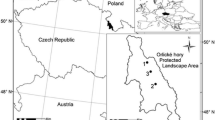Abstract
The forests of Abies religiosa Schl. et Cham. in the north and the northeast slopes of the mountains of the southwestern region of the Valley of Mexico are in an acute process of decline, particularly the fir forest of the Cultural and Recreational Park Desierto de los Leones. The mortality of the trees began in 1981, and by 1987 30% of the trees of the Park had died; the mortality continues. The surviving trees are in a very poor crown condition, having thin crowns with many dead branches. in the light of current knowledge air pollution, in particular the oxidant gases (ozone), are the primary cause of decline, but other conditions or agents (age of the trees and diseases) could be contributing factors in the dying of the trees.
Similar content being viewed by others
References
Alvarado Rosales, D., and Hernández Tejeda, T., Ma. de L. de la I. de Bauer y J. Galindo A.: ‘Declinación y muerte del bosque de oyamel en el sur del Valle de México: Síntomas, desarrollo y posibles causas’, En Memoria XIX Congreso Nacional de Fitopatología (En Prensa).
Anónimo, 1986: ‘Informe sobre el estado del ambiente en México’, Secretaría de Desarrollo y Ecología, 83 pp.
Bravo A. F., Perrin, F., Sosa, R., and Torres, R.: 1987, ‘Contaminación atmosférica por fuentes móviles. Zona metropolitana de la Ciudad de México’, in: Tercer Encuentro Iberoamericano sobre la Ciudad, Colegio de Ingenieros Civiles de México, A.C., Jornadas Técnicas sobre Medio Ambiente. D.D.F. 27–31.
DeBauerMa. de L.de la Isla.: 1972, ‘Uso de plantas indicadoras de aeropolutos en la Ciudad de México’, Agrociencia 9 (0), 139–141.
FerrellT.: 1980, ‘Risk-Rating Systems for Mature Red Fir And White Fir in Northern California’, Gen. Tech. Rep. PSW-39, Pacific South West Forest and Range Exp. Stn., Forest Serv., U.S. Dep. Agric. Berkeley, Calif., 29 pp.
Girón HurtadoE.: 1985, ‘El cielo de mi ciudad’, Consejo Nacional de Ciencia y Tecnología, México, D.F., Información científica y tecnológica 8, 25–27.
Hernández TejedaT., Ma. de L.de la Isla deBauer y S.Krupa.: 1982, ‘Daño por gases oxidantes en pinos y avena, reconocimiento y evaluación en el Ajusco, D.F.’, Rev. Chapingo 33–34, 19–28.
Hernández TejedaT. y M. L.De la Isla deBauer: 1984, ‘Evolución del daño por gases oxidantes en Pinus hartwegii y P. montezumae var', Lindleyi en el Ajusco, D.F.’, Chapingo, México, Agrociencia 56, 183–194.
Trigo Boix, N., S. Urbina Loyola y S. Márquez Hernández.: 1985, ‘Actualización del Proyecto “Inventario Diagnóstico del Desierto de los Leones’, (Inédito) Reporte Interno, INIF, 40 pp.
Author information
Authors and Affiliations
Additional information
Contribution from ‘Fourth World Wilderness Congress-Acid Rain Symposium, Denver (Estes Park), Colorado’, September 11–18, 1987.
Rights and permissions
About this article
Cite this article
Tovar, D.C. Air pollution and forest decline near Mexico City. Environ Monit Assess 12, 49–58 (1989). https://doi.org/10.1007/BF00396728
Issue Date:
DOI: https://doi.org/10.1007/BF00396728




